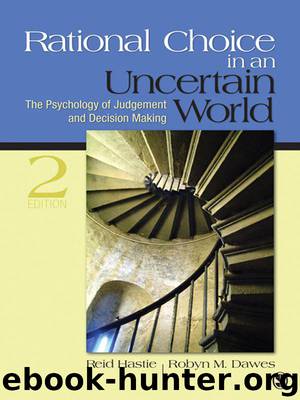Rational Choice in an Uncertain World: The Psychology of Judgment and Decision Making by Reid Hastie & Robyn M. Dawes

Author:Reid Hastie & Robyn M. Dawes [Hastie, Reid]
Language: eng
Format: mobi, epub
ISBN: 9781483342849
Publisher: SAGE Publications
Published: 2009-11-16T14:00:00+00:00
What do you think is the probability that the cab in the accident was Green, as the witness claimed? (p. 211)
Let’s represent the information of the problem in terms of Bayes’ theorem: In this problem, the most relevant base rate corresponds to the proportions of green and blue cabs on the streets, and it should be used as the starting point for the judgment—the “prior probability” of green before any case-specific evidence (e.g., the witness’s testimony) is heard. What Bar-Hillel (1980) found, when she presented the problem to a varied sample of people, was almost universal failure to consider the base rate; once they heard about the concrete, case-specific eyewitness testimony, the base rate faded into the background. Thus, Bar-Hillel found that the modal response was the eyewitness’s accuracy rate (.80), with no adjustment for the base rate information. If we plug the numbers into the Bayes’ theorem formula (see Figure 8.7), we get the correct answer: .41.
We should acknowledge here that there is ambiguity in the written problem statement: Is the witness accuracy already conditioned on the base rate of green cabs, a posterior probability, because the witness was tested under “15% green cabs” conditions? Moreover, there are other interpretations that depart from the information in the problem statement by assuming that readers import various kinds information into their problem representations from their background experiences with taxicabs or traffic accidents or eyewitnesses (see, for example, Birnbaum, 1983). However, there is no direct evidence that these alternative representations are conceived of by anyone except the experts intent on criticizing Bar-Hillel’s conclusions by speculating about alternate representations. In fact, unpublished data collected by one of the authors (Hastie) is most consistent with Bar-Hillel’s interpretation that college students comprehend the problem as in the Bayes formula format presented above, but ignore the base rate information.
Download
Rational Choice in an Uncertain World: The Psychology of Judgment and Decision Making by Reid Hastie & Robyn M. Dawes.epub
This site does not store any files on its server. We only index and link to content provided by other sites. Please contact the content providers to delete copyright contents if any and email us, we'll remove relevant links or contents immediately.
The Art of Thinking Clearly by Rolf Dobelli(10133)
Mindhunter: Inside the FBI's Elite Serial Crime Unit by John E. Douglas & Mark Olshaker(9099)
Change Your Questions, Change Your Life by Marilee Adams(7558)
Nudge - Improving Decisions about Health, Wealth, and Happiness by Thaler Sunstein(7456)
Mastermind: How to Think Like Sherlock Holmes by Maria Konnikova(7155)
The Power of Now: A Guide to Spiritual Enlightenment by Eckhart Tolle(5529)
Men In Love by Nancy Friday(5108)
Altered Sensations by David Pantalony(5001)
Factfulness: Ten Reasons We're Wrong About the World – and Why Things Are Better Than You Think by Hans Rosling(4621)
The Confidence Code by Katty Kay(4154)
Thinking in Bets by Annie Duke(4117)
Man and His Symbols by Carl Gustav Jung(4004)
The Worm at the Core by Sheldon Solomon(3394)
Why Buddhism is True by Robert Wright(3370)
Three Women by Lisa Taddeo(3319)
Liar's Poker by Michael Lewis(3316)
The Inner Life of Animals by Peter Wohlleben(3194)
Descartes' Error by Antonio Damasio(3185)
The Power of Mindful Learning by Ellen J. Langer(3129)
